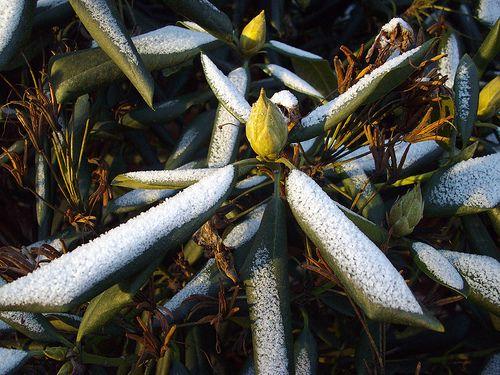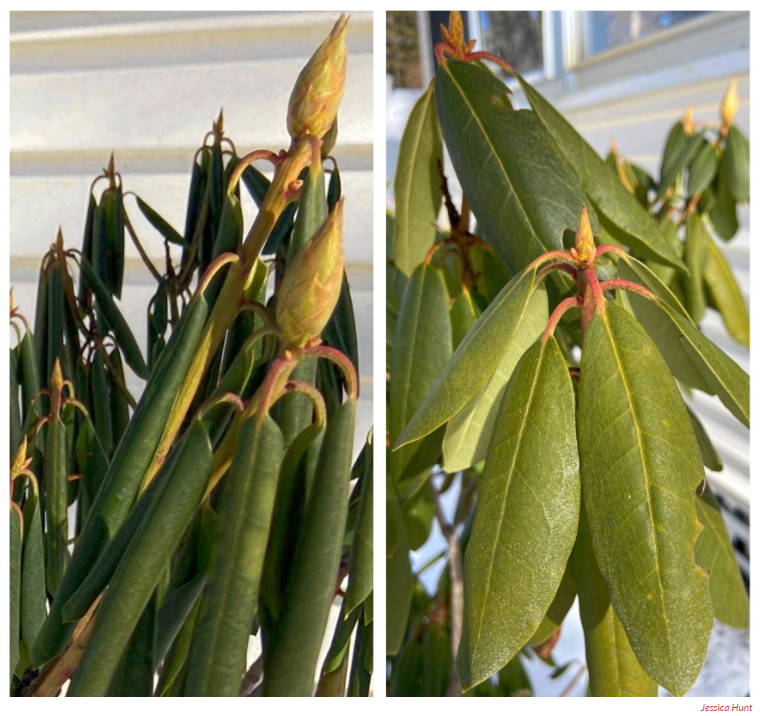- Tags:
- Something Wild

Rhododendron leaves curl in the cold. (Photo: Judah Morford, flickr)
When you step outside on a cold winter’s day, have you noticed how rhododendron leaves change their appearance? Usually, they are glossy and full. But when it’s cold, they curl up on themselves and almost look like they’re shivering. You can practically gauge the ambient temperature based on how those leaves look.

In a Seacoast Online article, nature writer Susan Pike says she’s observed when the rhododendron leaves change: “at around 25 degrees Fahrenheit, the leaves start to curl, and by 20 degrees Fahrenheit, they are as tightly curled as they can get.”
This phenomenon has a botanical name: thermonasty. The ‘thermo’ part is clearly related to the temperature. But ‘nasty’?
That’s from ‘nastic movement.’ It means the plant is reacting to an external stimulus. Other plants that exhibit nastic movement include Mimosa, also called Sensitive plant, or a Venus fly trap, which closes on insect prey “Little Shop of Horrors” style. But both of these are responding to touch.
Rhododendrons are responding to temperature. Having broad flat leaves poses some physiological challenges for plants in the winter. Rather than curl up to stay warm like an animal might, they curl to conserve water in winter when it’s frozen in soil.
You may have thought they were trying to avoid drying out in cold air. That’s part of it, but they’re really minimizing damage from the sun. Leaf pores, called “stomates,” are usually already closed in winter; they’re not photosynthesizing.
So why curl up?
It’s actually better if leaves stay shaded so they don’t warm up. Otherwise it will jump-start photosynthesis at a time when no water is available. That’s why commercial landscapers often advise people to wrap evergreen shrubs in burlap in the winter – to keep them shaded, and to protect their thick waxy outer leaf layer, called the “cuticle,” from the drying of winter winds.
The how is a bit more complicated. A plant hormone called abscisic acid triggers the leaf-curling. A section at the base of the leaf called a “pulvinus” rapidly changes the orientation of the leaf.
Relatively rapid leaf movement is one cold-adaptation for hardy broad-leaved evergreens that grow near the northern limit of their range in New Hampshire.
When people hear the term “evergreen” they usually think of needle-leaved forests of pine or spruce. But here, we’re referring to broad-leaved trees and shrubs that are truly specialized, managing to thrive in the doubly-challenging conditions of damp soil and freezing temperatures.
This family of Ericaceous plants conserve sparse nutrients in acidic soils by keeping their leaves year-round. They photosynthesize even in colder months, if temperatures remain mild enough. They use a lot of water during the growing season, but need to be frugal with water when the soil freezes.
Ericaceous shrubs include azaleas, bog rosemary, mountain laurel, leatherleaf, and Lapland rosebay. They are more common in the hardwood understory of forests in the central Appalachians, where they often form impenetrable thickets.
In New Hampshire, our native rhododendron is Canada rosebay, also called Rhodora. In June it blooms purple along lakeshores. The plants in Rhododendron State Park in Fitzwilliam are Rhododendron maximum, a species that occurs at its most northern location in southwestern N.H.
Identification can get confusing because there are also cultivated varieties of rhododendrons used in landscaping, and these sometimes naturalize in sheltered areas.
Something Wild is a partnership of the Forest Society, NH Audubon and NHPR.
